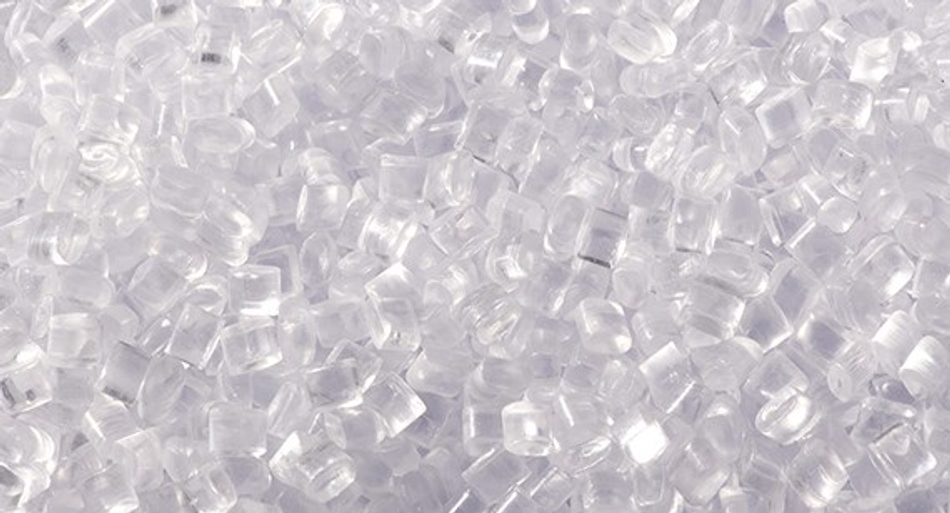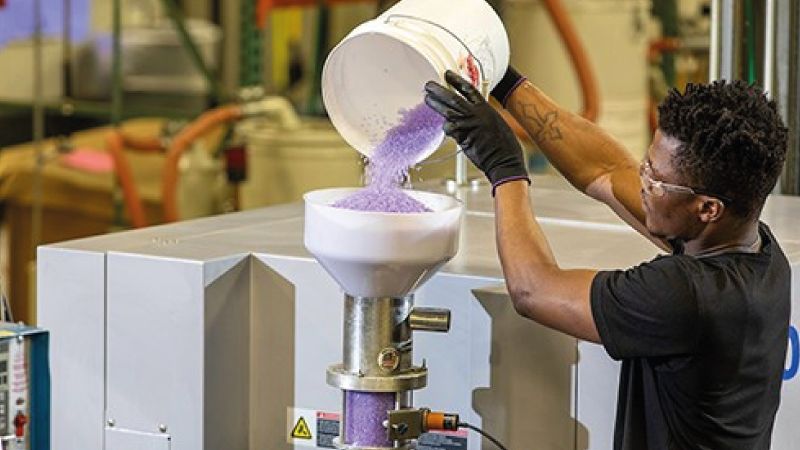Common Impact-Resistant Plastics
Looking for thermoplastics that can take a solid hit without breaking? Here are five impact-resistant polymers to consider for your next project.
Tough. Fracture-proof. Able to withstand punctures and cracks when struck. That’s how some people describe impact-resistant plastic. As you’ll see, however, that term is ambiguous. Just because a piece of chewing gum doesn’t break in two when hit with a hammer doesn’t mean it’s impact-resistant. For that matter, stick that same piece of gum in the freezer for a while and then give it a whack. Shrapnel.
This same “brittle when cold” phenomenon occurs with many polymers—drop your polypropylene (PP) recycling bin in the dead of winter and you’ll probably need a new one. Other plastics such as polyetheretherketone (PEEK) can take abuse at almost any temperature, while some (quite a few, actually) gradually grow brittle when exposed to UV light. One example is the otherwise tough polyoxymethylene (POM), also known as acetal, which turns wimpy if left in the sun too long, as does one of the most impact-resistant polymers of all, polycarbonate (PC).
Identifying Impact-Resistant Plastics
Because of these variables, it's essential to evaluate material options before starting any project and choose from those that will perform well in the product’s intended environment. One way to begin is by reviewing the plastic manufacturers’ data sheets. There, you’ll see terms like “Notched Izod Impact” and “Gardner Impact” and “Instrumented Dart Impact.” Each of these is defined under various ASTM and ISO standards (the ISO 179 Charpy Impact Test, for instance, or the Multiaxial Impact ASTM D3763), and each tries to define how materials will react when struck.
The basic premise behind each is to use controlled conditions and strike a sample of a given material and see how it withstands the impact. The notched IZOD test uses a pendulum that rotates downward and strikes a mounting bracket that hits the plastic. The Gardner test uses a weight that drops straight down onto a rounded, dart-like object sitting atop the material. The amount of weight and height needed to create damage provides the impact resistance. Ultimately, the greater the impact needed to crack the plastic, the higher its impact resistance.

Given the many standards, your engineering department should determine which ones they will use during product design, so you can perform an apples-to-apples comparison. Unfortunately, the variety of standards can be confusing, each referring to different testing methods and ways to prepare test samples. There are varying stats provided in data sheets and the pesky issue of metric vs. imperial units rears its head all of the time. Some data sheets don’t offer any impact test values but provide tensile modulus strength, flexural strength, elongation at yield, and hardness values, all of which at least give clues about the material’s strength. Be aware, though, that strength and toughness are often contradictory—greater strength usually denotes a higher level of brittleness, the exact opposite of impact resistance.
Much of a polymer’s strength or toughness is due to its glass transition temperature (Tg) and whether the plastic is amorphous or semi-crystalline. There’s no room for all that here, but we have another design tip explaining this important topic. Check it out if you need a deeper understanding.
In addition, practically all material properties vary based on the manufacturer and whether they are intended for CNC machining, plastic injection moulding, or 3D printing. It means that the materials may behave differently under certain conditions.
Proof is in the Pudding
So, what’s the answer? There are several, actually. If your company has invested in finite element analysis (FEA) software, congratulations. A good one will allow you to upload different materials and their properties, select variables such as temperature and loading, then whack virtual parts with virtual hammers to see how they respond. But even without high-end engineering software, SOLIDWORKS, Fusion 360, and other popular CAD packages offer innate FEA capabilities or FEA add-ons for a reasonable cost.
In the end, if you let us know your product application we can try different material blends or additives like glass and fibre that help improve specific characteristics. We do it every day.
5 Common Impact-Resistant Materials
Here then are “five impact-resistant materials” as promised at the beginning of this design tip. It is by no means a comprehensive list, and as discussed, toughness depends on many factors, not the least of which is part geometry. More on this at the end.
1. ABS
Unlike most amorphous polymers, acrylonitrile butadiene styrene (ABS) is opaque. It’s also very tough and impact resistant, even at low temperatures. Your car's dashboard might be made of ABS, as are the 9,036 Lego blocks in the Roman Colosseum model you've been working on for the past three weekends. ABS is both hard and rigid, electrically insulative, extremely mouldable, and can be recycled over and over again. However, it does not fare well in the face of solvents or lengthy stays in the sun, or applications where high fatigue resistance is required. As with the next material, we machine, 3D print, and injection mould ABS and ABS-like materials.
2. PC
The stuff of bulletproof glass, polycarbonate (PC) rocks at impact resistance. Think of it as the yin to acrylic’s hard, scratch-resistant yang. PC can withstand repeated steam sterilisations, so it sees widespread use in medical applications. It's also resistant to heat, flame, and UV light when properly treated, making it the first choice for everything from greenhouses to safety glasses, and headlight bezels to riot shields. Be aware that PC is one of the more expensive engineering polymers, though, and should be coated to prevent scratches if optical transparency is a concern.

3. HDPE
Some manufacturers claim that high-density polyethylene (HDPE) is not only the most versatile of all plastics but also the most widely used. They're probably right. HDPE is available in rigid or flexible forms and is lightweight yet strong. Automakers use it for gas tanks, dairy providers for milk containers, and outdoor furniture manufacturers for, well, outdoor furniture. Each of these applications requires good impact resistance, and just as it does when it’s exposed to sunlight and chemicals, HDPE delivers.
4. PP Impact Copolymer
Not only has very high impact resistance, but also has very good thermal stability. 500-GA20 is a high melt flow rate impact copolymer for injection moulding. Applications include housewares, containers, car batteries, toys, compounds and consumer products.
5. PTFE
This last one might surprise you. PTFE, aka polytetrafluoroethylene, aka Teflon, is soft and squishy but exceptionally tough. Its impact resistance is superior to PEEK, most polycarbonates, and on par with HDPE. It also boasts a very low coefficient of friction, second only to diamond-like carbon (DLC) and the super-hard ceramic aluminium-magnesium boride. If you’re looking for injection moulded or 3D-printed Teflon parts, move along—thanks to its very high melting point at 327 °C , PTFE is machinable, but that's about it. Be aware, though, that it tends to creep under pressure, so it should be mechanically constrained when using it for washers, bearings, and other load-bearing applications.
There are others such as polyphenylsulfone (PPSU), PEEK, TPE or thermoplastic elastomer, and even some nylons and acetals. Here again, impact resistance often comes down to the application temperature and is mitigated by tensile strength, UV-resistance, and other factors. Don't hesitate to make some sample parts and compare them before committing to one material or another.
Before we go, there's one final point to all this, and it's perhaps the most important point of all: product design's role in impact resistance. For instance:
- Notches and sharp corners tend to increase the chance that a part will break under force, whereas rounded corners tend to make parts more durable.
- When using stiffening ribs, place them in areas of compression rather than tensional forces, just as weld lines should ideally be located where potential impact forces are lowest.
- Although it sounds counterintuitive to an engineer, try to avoid rigid, very stiff product designs—a part that can give a little bit under pressure is less likely to fail.
Finally, be sure to share any concerns with us during the quoting phase. We have decades of manufacturing experience and are here to help you find the right material and a design that will bring success.


